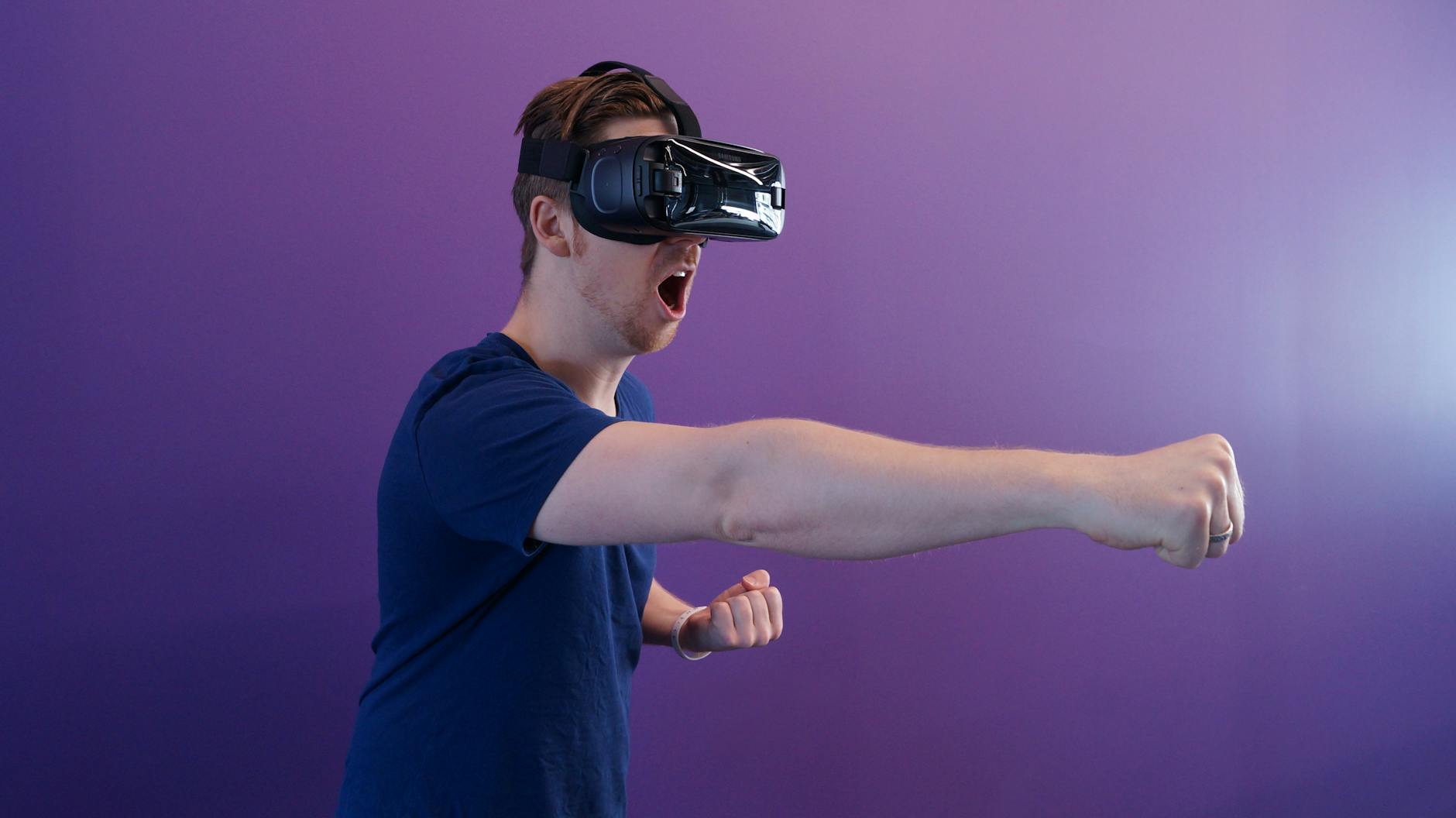Introduction to virtual reality in the entertainment industry
In the ever-evolving landscape of the entertainment industry, virtual reality (VR) has emerged as a game-changer, offering immersive and captivating experiences that blur the lines between reality and fantasy. As we delve into this technological marvel, we are witnessing a revolution that is transforming the way we consume and engage with entertainment.
Virtual reality has the power to transport us to realms beyond our wildest imaginations, allowing us to explore intricate worlds, interact with characters, and participate in narratives like never before. From the comfort of our homes or specialized venues, we can embark on thrilling adventures, witness breathtaking spectacles, and create unforgettable memories.
As the entertainment industry embraces this cutting-edge technology, we are witnessing a paradigm shift in how we experience and consume various forms of entertainment. Let us delve into the realms where virtual reality is leaving an indelible mark.
The impact of virtual reality on the entertainment industry
The impact of virtual reality on the entertainment industry has been profound and far-reaching. It has opened up new avenues for storytelling, immersive experiences, and audience engagement. By offering a level of realism and interactivity that was once unimaginable, virtual reality has captivated audiences and pushed the boundaries of what is possible in the realm of entertainment.
- Immersive Experiences: Virtual reality allows users to step into virtual worlds and experience them as if they were physically present. This level of immersion creates a sense of presence and engagement that traditional forms of entertainment cannot match.
- Interactive Storytelling: With virtual reality, storytellers can craft narratives that unfold around the viewer, allowing them to interact with characters, objects, and environments in ways that were previously impossible.
- Enhanced Realism: The ability to simulate realistic environments and scenarios has opened up new possibilities for training, education, and even therapeutic applications within the entertainment industry.
As the technology continues to evolve and become more accessible, the potential for virtual reality to reshape the entertainment landscape is boundless.

Virtual reality in gaming: immersive experiences and realistic simulations
The gaming industry has been at the forefront of virtual reality adoption, leveraging its capabilities to create immersive and realistic gaming experiences. From first-person shooters to role-playing games, virtual reality has revolutionized the way we interact with digital worlds.
- Immersive Gameplay: Virtual reality headsets transport gamers into the heart of the action, allowing them to look around, move freely, and interact with their surroundings in a way that feels natural and intuitive.
- Realistic Simulations: Virtual reality has enabled the creation of highly realistic simulations, from realistic combat scenarios to intricate racing environments, providing an unparalleled level of realism and engagement.
- Social Gaming Experiences: With the advent of multiplayer virtual reality games, players can now engage in shared experiences, collaborating or competing with friends and strangers from around the world in virtual environments.
As the technology continues to advance, we can expect even more groundbreaking gaming experiences that push the boundaries of what is possible in the realm of virtual reality.
Virtual reality in movies and television: enhancing storytelling and viewer engagement
The film and television industries have also embraced virtual reality as a means to enhance storytelling and viewer engagement. By offering immersive experiences that extend beyond the traditional screen, virtual reality has the potential to revolutionize the way we consume and interact with visual narratives.
- 360-Degree Filmmaking: Virtual reality allows filmmakers to create 360-degree environments, enabling viewers to experience scenes from multiple angles and perspectives, adding depth and immersion to the storytelling process.
- Interactive Narratives: Virtual reality offers the potential for interactive narratives, where viewers can influence the course of the story through their actions and choices, creating a unique and personalized viewing experience.
- Virtual Reality Experiences: In addition to traditional film and television content, virtual reality experiences are being created that allow viewers to step into the worlds of their favorite shows or movies, exploring environments and interacting with characters in ways that were previously impossible.
As the technology continues to evolve, we can expect to see more innovative and engaging virtual reality experiences in the realm of film and television, redefining the way we consume and experience visual narratives.
“The revolution in the entertainment industry has transformed storytelling into an immersive experience, breaking traditional boundaries and democratizing voices. It’s a vibrant, complex landscape where narratives provoke thought, challenge norms, and inspire change. In this new era, television and digital platforms have become powerful mediums that reflect and shape the intricacies of our society.”
Virtual reality in live events: transforming the way we experience concerts and sports
Live events, such as concerts and sports, have also been transformed by the advent of virtual reality. By offering immersive and interactive experiences, virtual reality has the potential to revolutionize the way we experience these events, bridging the gap between the audience and the action.
- Virtual Concert Experiences: Virtual reality allows music fans to experience concerts from the best seats in the house, or even from the stage itself, providing a level of immersion and intimacy that was previously unattainable.
- Courtside Seats: In the world of sports, virtual reality offers the opportunity to experience events from the best seats in the arena, or even from the perspective of the players themselves, creating a level of engagement that was once reserved for those in attendance.
- Interactive Experiences: Beyond just spectating, virtual reality can also offer interactive experiences, such as virtual meet-and-greets with performers or athletes, or even the ability to participate in virtual training sessions or behind-the-scenes tours.
As the technology continues to evolve, we can expect to see more innovative and engaging virtual reality experiences in the realm of live events, bringing audiences closer to the action than ever before.
Virtual reality in theme parks: creating unforgettable rides and attractions
Theme parks have long been at the forefront of innovative and immersive experiences, and virtual reality has the potential to take these experiences to new heights. By combining virtual reality with traditional rides and attractions, theme parks are creating unforgettable experiences that blur the lines between reality and fantasy.
- Virtual Reality Rides: Theme parks are incorporating virtual reality headsets into traditional rides, allowing guests to experience the thrill of the ride while being transported to fantastical worlds and environments.
- Interactive Attractions: Virtual reality can also be used to create interactive attractions, where guests can explore virtual environments, solve puzzles, and interact with characters in ways that were previously impossible.
- Educational Experiences: Beyond just entertainment, virtual reality can also be used to create educational experiences in theme parks, allowing guests to explore historical locations, learn about different cultures, or even travel through time and space.
As theme parks continue to embrace virtual reality, we can expect to see even more innovative and immersive experiences that push the boundaries of what is possible in the realm of entertainment.

Virtual reality in adult entertainment: exploring new possibilities and controversies
While virtual reality has opened up new possibilities in various entertainment industries, its application in the adult entertainment industry has been a topic of both excitement and controversy. As technology continues to advance, virtual reality has the potential to reshape the way we experience and consume adult content.
- Immersive Experiences: Virtual reality offers the ability to create highly immersive and realistic adult experiences, allowing users to engage with virtual environments and characters in ways that were previously impossible.
- Ethical Considerations: While virtual reality in adult entertainment may offer new possibilities, it also raises ethical concerns regarding the portrayal of consent, exploitation, and the potential for addiction or desensitization.
- Technological Challenges: Developing high-quality and realistic virtual reality experiences in the adult entertainment industry presents unique technological challenges, including the need for advanced motion capture, rendering, and simulation capabilities.
As the industry continues to explore the potential of virtual reality, it is crucial to address these ethical and technological considerations to ensure responsible and ethical development and consumption of virtual reality adult content.
Challenges and limitations of virtual reality in the entertainment industry
While virtual reality has revolutionized the entertainment industry, it is not without its challenges and limitations. As we continue to push the boundaries of this technology, it is essential to address these issues to ensure a seamless and enjoyable experience for users.
- Technical Limitations: Despite significant advancements, virtual reality technology still faces limitations in terms of resolution, field of view, and processing power, which can impact the overall immersion and realism of the experience.
- Motion Sickness: Some users may experience motion sickness or discomfort when using virtual reality, particularly during prolonged or intense experiences, which can limit the adoption and enjoyment of the technology.
- Cost and Accessibility: Virtual reality hardware and software can be expensive, limiting accessibility for some users and potentially hindering widespread adoption in the entertainment industry.
- Content Creation Challenges: Developing high-quality and engaging virtual reality content requires specialized skills, tools, and resources, which can be costly and time-consuming for content creators.
By addressing these challenges and limitations, the entertainment industry can continue to push the boundaries of virtual reality and create even more immersive and captivating experiences for audiences worldwide.
The future of virtual reality in entertainment: trends and predictions
As virtual reality technology continues to evolve, the entertainment industry is poised for even more exciting developments and innovations. Here are some trends and predictions for the future of virtual reality in entertainment:
- Increased Accessibility and Adoption: As virtual reality hardware and software become more affordable and user-friendly, we can expect to see increased adoption and accessibility across various entertainment sectors, from gaming and movies to live events and theme parks.
- Advancements in Haptic Technology: Haptic technology, which simulates the sense of touch and physical feedback, is expected to play a significant role in enhancing the immersive experience of virtual reality in entertainment.
- Integration with Artificial Intelligence: The integration of artificial intelligence (AI) with virtual reality could lead to more intelligent and adaptive virtual environments, characters, and narratives, creating personalized and dynamic entertainment experiences.
- Social and Collaborative Experiences: Virtual reality is expected to facilitate more social and collaborative experiences, allowing users to interact and engage with others in shared virtual environments, fostering a sense of community and shared experiences.
- Convergence with Other Technologies: Virtual reality is likely to converge with other emerging technologies, such as augmented reality (AR), mixed reality (MR), and extended reality (XR), creating new and innovative ways to experience and consume entertainment content.
As the future of virtual reality in entertainment unfolds, we can expect to witness even more groundbreaking and immersive experiences that push the boundaries of what is possible in the realm of entertainment.
Conclusion: the ongoing revolution of virtual reality in the entertainment industry
The rise of virtual reality has ushered in a revolution within the entertainment industry, offering immersive and captivating experiences that transcend traditional forms of entertainment. From gaming and movies to live events and theme parks, virtual reality has opened up new avenues for storytelling, audience engagement, and unforgettable adventures.
As we continue to explore the possibilities of this cutting-edge technology, we are witnessing a paradigm shift in how we consume and interact with entertainment. Virtual reality has the power to transport us to realms beyond our wildest imaginations, allowing us to experience narratives, environments, and scenarios in ways that were once unimaginable.
While the journey of virtual reality in the entertainment industry is still in its early stages, the potential for growth and innovation is boundless. As technology continues to advance and the industry addresses challenges and limitations, we can expect to witness even more groundbreaking and immersive experiences that will redefine the way we perceive and engage with entertainment.
The Next Frontier: How Web 3.0 is Shaping the Future of the Internet
Exploring the Synergy Between Web 3.0 and AI: Revolutionizing the Digital Landscape
From Traditional to Modern: The Unavoidable Shift to Digital Business Transformation


